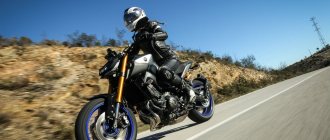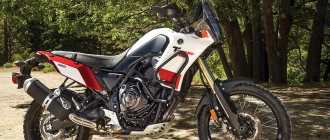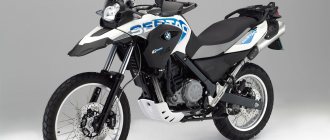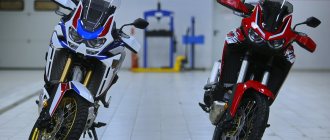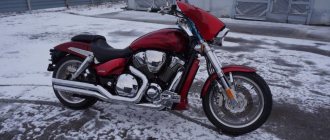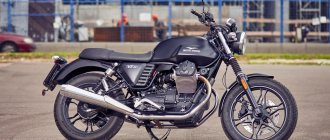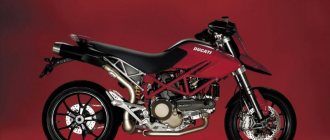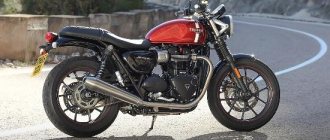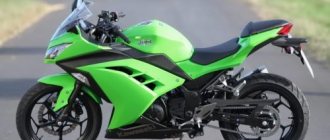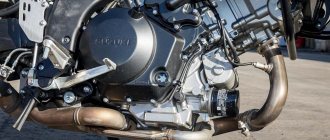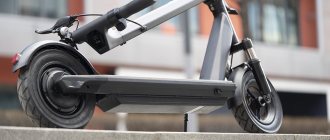000_MOTO_1110_026
Yamaha XT1200Z Super Tenere: touring enduro, 2010, 1199 cm³, 110 hp, 261 kg, 650,000 - 680,000 rub.
Yamaha XT1200Z Super Tenere: touring enduro, 2010, 1199 cm³, 110 hp, 261 kg, 650,000 - 680,000 rub.
Immediately after the appearance of official photographs of the new Super Tenere, two “shadows” appeared behind its “back”. One is from the past, the other is from the present, which, in principle, is natural. The name of the new product speaks of its relationship with its predecessor from 1989, and the external data and performance characteristics indicate its relationship with the main opponent of the present one, the famous “Bavarian”. Another thing is surprising: some wanted to see in the new XT1200Z the reincarnation of the old “Peterhansel fighting machine,” “but only better,” while others were looking forward to “Pimp” putting “Goose” in his belt. It was even a little sad to see how disappointed both of them were. What exactly is the brand new Super Tenere?
In reality, Super Tenere looks a little more massive than in the photographs. But this cannot be considered a disadvantage. At first glance, it is clear that this is a full-fledged touring enduro without any hint of versatility. You don’t even have to go anywhere to understand this. “Pimp” is a classic long-range all-terrain vehicle. This is not an “Italian”, which seems to be both in feast and in peace, but in reality it is a slightly “pushed up” sportbike. I didn’t make a reservation - this device, like, in general, all its other classmates, in off-road conditions will feel little better than another sports tourer or a classic: the mass makes itself felt, no matter what toothy tires you install, no matter how you increase the ground clearance, and pulling a three hundred kilo carcass out of a muddy rut is an unpleasant and often futile task.
Despite its enduronic nature, the layout of the device raises questions. Firstly, the oil filter is strangely located, sticking out in front of the engine as a “primary sexual characteristic”. On my copy from the first edition series, a high-quality aluminum crankcase protection is already installed at the factory, protecting the filter from adversity, but starting next year this part, important for enduro, will become an option. And not cheap at all. Secondly, the location of the cooling system radiators. The side-by-side layout undoubtedly made it possible to move the engine forward and improve the weight distribution of the device, but any, even the most harmless fall threatens to result in an antifreeze leak, and you won’t go far without it. This scheme is justified, for example, on a Honda VFR, but the “vyfer” by default is always within reach of a tow truck, because it was born to drive on asphalt, but what if you use the “Suter” in the African savannah or on the Caucasus mountain trail? In general, protective bars are strongly requested here. I think many people will not really like the need to modify the device with a file and a wallet. Although, knowing current customs, I’m almost sure that most of the Suters sold will never go further than a hundred meters from the asphalt, and the device still needs to be modified for serious hikes. So, it turns out that Yamaha has released another SUV? Or did she reduce the cost of the device due to options that are unnecessary for most?
008_MOTO_1110_026
The military-style tidy looks brutal.
But not at the expense of information content. The military-style tidy looks brutal. But not at the expense of information content.
In motion, the motorcycle turned out to be much “smaller” than it looked: 261 kilos are not felt at all. The device is a little difficult to corner at all speeds above walking speed; understeer here is inherent in the design - this way the bike is less susceptible to wobbles on rocks, ruts and other irregularities. This means that there is still potential for off-road driving. The work of the pendants also reinforces this idea. Even though there are no newfangled electrical adjustments for hydraulics and springs, the fork and rear monoshock absorber cope with the tricky conditions of asphalt, country roads and graders really well. Motik does not prowl, does not jump on grader waves and even easily digests jumps from low springboards. Despite all the “off-road” suspension settings, the motorcycle behaves on asphalt no worse than any other classic. Longitudinal swings during acceleration and braking are minimal.
The engine also performed excellently. 1199 “cc” confidently pull the car from the lowest speeds, although it is felt that for the sake of juicy traction at the “bottoms” and in the “middle”, the Yamaha team openly sacrificed the “tops”. Perhaps even too much. Although this option is not for everyone. For example, I generally prefer “low-level” engines, be it a car diesel engine or a chopper “top”, so it’s to my taste. The only “but” is the adjustment of the “electronic” throttle grip. The brains that control the throttle valves are a little, literally a split second, behind the pilot’s commands. It seems not much, but in some situations these tenths are not enough. For example, instead of moving quickly, the motorcycle simply stalls. Your hands automatically operate the gas and clutch, but here you need to apply the gas a little earlier, or start releasing the clutch a little later. It’s a matter of habit, of course, but somehow it doesn’t suit a serious person. Well, perhaps the last nuance of the XT1200Z engine is the sound of operation. Almost everyone who heard the Suter working for the first time asked if everything was okay with it. It's okay, guys! It's Yamaha! The engine is very talkative. Naturally, we are not talking about the exhaust, but rather about the polyphony of rattling hardware in the engine itself. Maybe some people won’t like this, but I was extremely pleased when I opened the gas and heard literally every piece of hardware in the engine. A real “combat” racing projectile. Have you ever heard how the engine of, for example, a rally car works?
There are no complaints about ABS: the system works predictably and smoothly. But the YCC-T stabilization system was a little disappointing. Instead of smoothly keeping a skid or slide within safe limits, allowing the pilot to enjoy the “wagging of the tail” during acceleration and turns with a skid, it smothers all “undesirable” tendencies in the bud, and very harshly. The difference between the “road” and “off-road” modes is only that if in the first YCC-T suppresses slips, drifts and attempts to tear off the front wheel in the bud, then in the second it turns on with some delay, although it works just as categorically . Competitors' similar systems are more finely tuned. But, unlike most, on the Suter the stabilization system can be turned off, and this is a definite plus. In short, YCC-T provides the necessary level of security, but harms the “drive”.
The purpose of the Yamaha D-Mode system on this motorcycle is not entirely clear. In fact, “the ability to change engine operating modes” comes down to only the ability to choose between two levels of throttle damping. Roughly speaking, if in the first mode the dependence of the opening angle of the throttle valves on the rotation of the knob is linear, then in the second - in order to drive “the same way”, you just need to turn the “knob” harder. Of course, on motorcycles such as, for example, the R1 with a crazy population under the tank and sharp engine reactions, such a system is justified, but here, on a “low-end” engine with excellent feedback on the throttle and “stabilizer”, this option is not more than a "bauble".
Overall ergonomics rating: good. The saddle is very comfortable for both the pilot and the passenger. Although you wouldn’t expect anything else, because at first glance you can see from which “German” its design was borrowed. And for him this part is considered almost an ideal in the class. The wide steering wheel is located exactly where it is needed, close enough to the pilot - you don’t have to reach for it, which means that the Suter will be comfortable not only for lanky people like me, but also for people of average height. But I would like to move the footrests a little forward: the sitting position is fine, but the stand is somehow uncomfortable - you have to lean over too much. Well, perhaps the last “ah-yay-yay” is the windshield adjustment system. Long ago, all “progressive humanity” switched to quick adjustment systems, be it latches or thumbscrews; here, in order to raise or lower the glass (there are only two positions), you need to arm yourself with a screwdriver.
Despite some shortcomings, I liked the motorcycle. Ergonomics, ease of control, comfort, engine and suspension settings, everything is worked out with high quality, and the rest are “baubles” and nuances that have little effect on the ride. The motorcycle is truly capable of being an excellent long-range projectile, both on paved roads and beyond. And the number and cost of potential modifications necessary to bring the device to “full combat readiness” will be small, given the price of the device itself. Super Tenere has turned out to be a really strong competitor to the current giants of the touring enduro class, and very soon it will prove it. In one of the upcoming issues of “Moto” we will pit the best of the best against each other, and I am sure that “Suter” will not give up!
Technical specifications of Yamaha XT1200Z Super Tenere (manufacturer data)
| COMMON DATA | |
| Model year | 2010 |
| Wheelbase, mm | 1540 |
| Curb weight, kg | 261 |
| Length x width x height, mm | 2250×980×1410 |
| Ground clearance, mm | 205 |
| Seat height, mm | 845–870 |
| Gas tank volume, l | 23 |
| ENGINE | |
| Type | R2, 4T |
| timing belt | DOHC, 4 valves per cylinder |
| Working volume, cm3 | 1199 |
| Dimension, mm | 98x79.5 |
| Compression ratio | 11:1 |
| Supply system | fuel injection |
| Cooling system | liquid |
| Starting system | electric starter |
| Max. power, hp at rpm | 110/7250 |
| Max. torque, Nm at rpm | 114,1/6000 |
| TRANSMISSION | |
| Clutch | multi-disc, oil bath |
| Transmission | 6-speed |
| main gear | cardan shaft |
| CHASSIS | |
| Frame | steel, spatial, closed through the power unit |
| Front suspension | inverted telescopic fork, fully adjustable |
| Pipe diameter, mm | 43 |
| Stroke, mm | 190 |
| Rear suspension | pendulum, with progressive characteristics and hydraulic shock absorber with adjustable spring preload and rebound force |
| Stroke, mm | 190 |
| Brake system | Hydraulic semi-combined (braking of both wheels from the steering lever), with ABS and stabilization system |
| Front brake | 2 discs ∅ 310 mm |
| Rear brake | 1 disk ∅ 282 mm |
| Wheels | aluminum spoked |
| Front tire | 110/80R19, tubeless |
| Rear tire | 150/70R17, tubeless |
The motorcycle for testing was provided by Yamaha Motor CIS, Dainese equipment was provided by the Eurosport-Motors salon.
Yamaha XT1200Z Super Tenere test
TEST DRIVE: Yamaha Tenere XT1200Z (2010) – Pros and cons
Although the motorcycle was taken for a long test, let's say, for a season, in just three weeks the most complete, multi-faceted test of 9000 km was completed, during which I tried to understand whether Yamaha had succeeded in its idea of creating a universal tour enduro - a competitor to the BMW R1200GS.
MOTOGONKI.RU, November 18, 2010 — TEST BEGINS: YAMAHA TENERE XT1200Z — THE DUTCH
Engine
Yamaha's requirement for fuel quality is one of the mysteries of this motorcycle: “Pour no less than 95 Super!” - warns the sticker on the gas tank. Theoretically, it is designed to conquer the toughest off-road terrain: Africa, South America and other endlessly unorganized lands. Where does “Super” come from in the outskirts of Zimbabwe?! In fact, the engine “ate” even the dubious quality “92” without any problems. The ignition is provided by two spark plugs in each cylinder plus the so-called “anti-knock” system. The real difference is only in consumption: the lower the octane number, the higher it is. So in this regard, Yamaha has performed a small technological miracle.
The Super Tenere engine is compact and very playful in the middle of the range, but at the bottom and at the top...
At the same time, for the first time in a long practice, I “dried out” between two refills. Calculating consumption using Super Tenere devices is not easy, I already wrote about this in the last issue. In theory, the XT1200Z consumes 9L/100km at 150km/h on the highway (compared to the R1200GS' 6.7L at the same pace). On the ground and when driving on roads of questionable quality, mileage increases significantly. One way or another, the price of the first division of the level indicator is 105-125 km, the second - about 75, the third - less than 50. It was possible to drive 210-250 km to the reserve volume. Finally, with the remaining 4 liters I managed to go 61 km before the engine died down. Then I saw the number “287” on the odometer, and I was only 5 km short of refueling (the companions on the BMW didn’t even have the “reserve” on at that time). But this is not the limit of the capabilities of the 2-cylinder 1199 cc “in-line” engine. Of course, it is designed for another application - climbing gravel roads at speeds of up to 90 km/h, climbing hard-to-reach mountain paths, overcoming fords and other off-roads. At the same time, you can travel 350 km on one gas station. But to get to the mountains, for example, from Moscow you need to cover almost 1,500 km and you will have to pay exorbitant prices for it! In any case, it is recommended to take an emergency supply of fuel with you.
The dashboard is very very spartan, however, this is 2010! But we already have Multistrada...
The first impressions of the engine were very vague: the first and second gears are “indistinct” and short, useless on the road, and it’s easy to block the engine with sloppy clutch operation. But when driving at low speeds, it's important to maintain balance, and the Super Tenere has a couple of tricks for this: the cylinder block is tilted forward with two overhead camshafts and two balancer shafts, and the engine itself sits as low as possible in the frame. The all-terrain vehicle steers perfectly, even too easily, despite almost 300 kg when fully loaded...
Vibrations are something that cannot be avoided, even if armed with balancers. The creepiest and most disturbing ones begin at 4000 rpm. and decrease by about 5000 rpm. At this moment, a second wind seems to open in the engine and a significant pickup is felt. Yamaha cruising speed is 120-130 km/h. This way you can avoid overspending. At the same time, the fifth and sixth gears are truly “rubbery”. So, reluctantly, but without hesitation, the XT1200Z starts from second, and as soon as the needle crosses the 80 km/h mark, switch to sixth and - forward, to the maximum (according to GPS) 195 km/h!
Chassis
Driving a loaded SUV on the highway at such speed is not easy. It's all due to the cleverly balanced chassis. In the first half of the journey, I constantly encountered the same problem that Valentino Rossi faced during the development of his Ducati Desmosedici: he could not fully load the front wheel so that it began to “work” in corners and on straights. The motorcycle accelerated to 160 km/h, the wheel began to “walk”, which several times led to wobbling on longitudinal irregularities. I solved the problem after numerous experiments with clamping the rear shock absorber: I managed to minimize the potentially dangerous effect. At the same time, Super Tenere did not care about the quality of coverage and other irritants.
Yamaha Super Tenere XT1200Z Frame
The long-awaited test was an exit onto the D1 highway, leading from east to west of the Czech Republic. 276 km of concrete road, built back in 1971. For any motorcyclist, driving along the D1, especially the first 100 km from Brno, is torture, especially in the right lane. The concrete blocks are not poured with perfect accuracy and are slightly inclined relative to each other, which creates a unique “comb” effect when driving, especially at speeds above 120 km/h. A month earlier, I drove this route twice on a “clean” Suzuki Burgman 650 road bike. I repeat, torture. With the Super Tenere chassis - complete indifference to the presence of joints and differences in slab heights! Q.E.D.
The ground clearance of more than 200 mm is enough to jump onto the curb at the right moment and sit in a place inaccessible to cars. In Warsaw I was caught in an incredible storm. Half of the city was submerged under water, flooding was observed everywhere, which led to many kilometers of traffic jams. Not for me! Three times I “waded” newly formed lakes in the middle of city highways, the water reached the gear shift foot. If it weren’t for the soaking wet touring motorcycle boots, I wouldn’t have paid any attention to the “puddles.” But the motorists... they had a hard time!
Wheels
Knowing that 90% of the journey would be on the highway, before the trip I installed the new Continental ContiTrailAttack, specially created for such motorcycles: mostly asphalt, with the ability to go off-road. Over the entire 9,000 km, there was not a single instance of stalling, despite the narrow “off-road” front and significantly overloaded rear. All thanks to the uniform distribution of the compound over the entire surface of the frame and a successful pattern: even in the most terrible bad weather, the entire tread area was used. After redistributing the load on the chassis, it was possible to better load the front-end, and finally, some wear appeared on the front tire... at about 6000 km!
Basic tires lasted only 5000 km. Therefore, before the test, brand new ContiTrailAttack was installed on the motorcycle - this is what we need!!!
The new “conti” are durable and grippy, they suited me perfectly. But if you know for sure that at least a third of the route lies off the asphalt, install ContiEscape “with checkers”. In truth, installing tires only “with the ability” to leave the road deprives Tenere of many of the purely off-road options built into it by its designers. I had to switch to the “TCS2” (Off-road) mode so that when driving onto mature grass and dirt, my rear wouldn’t go wild. Torque was electronically limited, traction was equalized by the YCC-T system. Otherwise, I would have ended up on my side.
High seat
Both good and bad. Of course, 870 mm in the base is convenient for off-road driving when you have to stand up on the pegs. On the highway, you want to sit as low as possible in order to hide behind the windshield that can barely cope with its duties. Luckily, the under-seat spacer can be removed or put back in place in a matter of seconds. You can take it with you and use it for its intended purpose. I would have done so, but I left it in the garage, which caused me to suffer in the mountains and on long hauls. With a low seating position (845 mm), the legs are in a significantly bent state, and the knee joints begin to ache after an hour and a half to two hours of riding. If I sat a little higher, the comfortable travel time would increase.
Baggage
The proprietary system of aluminum panniers left ambivalent impressions. They themselves are reliable - this is a plus. But I was disappointed with the interior design. The top 30-liter box fits one helmet and nothing else. What if something softer? Yes, you can “archive” your sleeping bag and “foam” with your knee, and again understand that this place has been exhausted. Active use of the container is limited by Yamaha's requirements for maximum loading, because the case itself weighs 5 kg, and you can't take it with you to your hotel room. The side cases are asymmetrical: the right one – 32 liters, the left one – 29: 3 liters of useful capacity are lost due to the proximity to the massive exhaust, and besides, it also gets hot.
About 50 kg of cargo constantly traveled with me. But the panniers themselves - they are supposed to hang on a motorcycle: they are heavy!
The useful total volume of the system in my case was only 60 liters out of a possible 90, so I had to load a 76-liter saddlebag. None of the side cases could fit a photo backpack: the set of equipment had to be divided into separate, small cases, and as a result, a lot of space was lost. The same backpack fit perfectly into the seat space of most of the tested maxi-scooters, as well as the panniers of BMW touring cars. All three Yamaha panniers are completely sealed - rain is not a problem.
Service on the go
XT1200Z displacement engine with 110 hp. at 7250 rpm, it would seem that it should give something more at low and medium speeds. But the maximum torque of 114 Nm occurs only at 6000 rpm.
The R1200GS has similar power, the “boxer” reaches its peak at the same speed, but its torque is “juicier” - 120 Nm. Yamaha engineers relied on the machine to be “twisted” in order for it to dig and grip. When you try to drive in a “comfortable” speed zone on asphalt, you involuntarily work the throttle and accelerate. I'm not sure if this applies to all XT1200Zs, but the test subject suffered from oil gorging. During the trip I changed all 3.5 liters - by topping up. I associate this with long hauls in modes from 5000 to 6000 rpm. You should factor in your travel expenses and take a couple of liters of Yamalube with you (it’s not easy to find branded oil in Europe, and even more so in the Russian outback). No other expenses were required to maintain the motorcycle during the entire run.
Yamaha Super Tenere (2010) in red and blue
But they might appear! First of all, due to the not very convenient position of the “parking” selector in the ignition switch. It's easy to miss the steering wheel lock and ignore the side lights in bright sunlight. Once, I was almost left without power - in just 4 hours of parking the battery was completely dead. Fortunately, through the efforts of three mechanics of the British racing team, they managed to start the Super Tenere from a “push start” - they simply pushed me away. Charging the gel battery to 70% took about an hour and a half, for which we used a “smart” device: “You need to keep your eyes open with this battery: you shouldn’t charge it head-on - you’ll lose up to 25% of the power,” noted the owner of a motorcycle service center.
...just don't forget to change the road Battle Wing to the trailing Trail
Total
Is it worth overpaying 206 thousand for the BMW R1200GS in the basic configuration, 240 thousand for the Adventure, or taking the Super Tenere? It's unlikely that I would buy a Yamaha for everyday use. That's not what he's for. And for tourism? Just not for trips to Europe! Rather, in the opposite direction - to the outback of Russia, for a trip to Ukraine, the Far East. I wouldn’t mind having the motorcycle travel part of the way in the back of a support vehicle.
This is the difference: in the deeper and more comfortable BMW saddle, such thoughts did not even occur to me! And the cost per kilometer for the GS is significantly lower than 4 rubles, all other things being equal. But if there are no tasks to overcome 1500 km per day, and you are ready to slowly and economically travel 600-700 km per day, the XT1200Z is your choice.
START OF TEST: YAMAHA TENERE XT1200Z – THE DUTCH
Yamaha Tenere XT1200Z (2010): 1199 cm3, 110 hp. s., curb weight - 261 kg.
Total mileage during testing: 9000 km Gasoline costs (790 l): about 1050 euros Other costs: 3.5 liters Yamalube p/s - 52 euros. Net cost of 1 km run: 0.12 euros
The motorcycle was provided by www.yamaha-motor.ru First published in MOTOREVYU magazine 9/2010 and 10/2010 Photo by the author and Yuri Banchukov.
